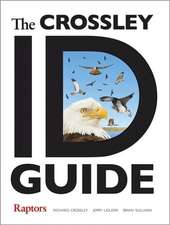Bird Migration: Physiology and Ecophysiology
Editat de Eberhard Gwinneren Limba Engleză Paperback – 12 dec 2011
Preț: 1224.18 lei
Preț vechi: 1492.91 lei
-18% Nou
Puncte Express: 1836
Preț estimativ în valută:
234.25€ • 244.09$ • 193.96£
234.25€ • 244.09$ • 193.96£
Carte tipărită la comandă
Livrare economică 03-17 aprilie
Preluare comenzi: 021 569.72.76
Specificații
ISBN-13: 9783642745447
ISBN-10: 364274544X
Pagini: 452
Ilustrații: XII, 435 p. 3 illus.
Dimensiuni: 155 x 235 x 24 mm
Greutate: 0.63 kg
Ediția:Softcover reprint of the original 1st ed. 1990
Editura: Springer Berlin, Heidelberg
Colecția Springer
Locul publicării:Berlin, Heidelberg, Germany
ISBN-10: 364274544X
Pagini: 452
Ilustrații: XII, 435 p. 3 illus.
Dimensiuni: 155 x 235 x 24 mm
Greutate: 0.63 kg
Ediția:Softcover reprint of the original 1st ed. 1990
Editura: Springer Berlin, Heidelberg
Colecția Springer
Locul publicării:Berlin, Heidelberg, Germany
Public țintă
ResearchDescriere
E. GWINNER! The phenomenon of bird migration with its large scale dimensions has attracted the attention of naturalists for centuries. Worldwide billions of birds leave their breeding grounds every autumn to migrate to areas with seasonally more favor able conditions. Many of these migrants travel only over a few hundred kilo meters but others cover distances equivalent to the circumference of the earth. Among these long-distance migrants are several billion birds that invade Africa every autumn from their West and Central Palaearctic breeding areas. In the Americas and in Asia the scope of bird migration is of a similar magnitude. Just as impressive as the numbers of birds are their achievements. They have to cope with the enormous energetic costs of long-distance flying. particularly while crossing oceans and deserts that do not allow replenishment of depleted fat reserves. They have to appropriately time the onset and end of migrations. both on a daily and annual basis. And finally. they have to orient their migratory movements in space to reach their species- or population-specific wintering and breeding grounds, irrespective of the variable climatic conditions along their migratory routes.
Cuprins
1 Patterns of Migration.- The Orientation of Transoceanic Migrants.- Bird Migration in the Arctic: A Review.- Palaearctic Passerine Migrants in Kenya and Uganda: Temporal and Spatial Patterns of Their Movements.- Migration Across the Alps.- Timing of Bird Migration in Relation to Weather: Updated Review.- Aspects of the Molt Migration.- 2 Ecological and Behavioral Aspects of Migration.- Site Attachment and Site Fidelity in Migratory Birds: Experimental Evidence from the Field and Analogies from Neurobiology.- Ecophysiological Aspects of Movements by Migrants in the Wintering Quarters.- Control of Partial Migration and Autumnal Behavior.- Selection and Use of Habitat of Wintering Migrants.- Some Ecological Aspects of Migrants and Residents.- 3 Physiological Adaptations to Migration.- The Visual Problems of Nocturnal Migration.- Nutrition and Food Selection in Migratory Birds.- Fat Storage and Fat Metabolism in Relation to Migration.- Endocrine Mechanisms of Migration.- Circannual Rhythms in Bird Migration: Control of Temporal Patterns and Interactions with Photoperiod.- Genetics of Migration.- 4 Avian Flight.- The Mechanics of Flight and Bird Migration Performance.- The Physiology of Bird Flight.- Wind Tunnel Measurements of Long-Time Flights in Relation to the Energetics and Water Economy of Migrating Birds.- 5 Strategies and Tactics of Migration.- Optimal Bird Migration: The Relative Importance of Time, Energy, and Safety.- Strategies of Trans-Sahara Migrants.- Bird Migration Across Arid and Mountainous Regions of Middle Asia and Kasakhstan.- Migration Strategies and Tactics of Waders Breeding in Arctic and North Temperate Latitudes.- An Exploration of the Energetics of Leap-Frog Migration in Arctic Breeding Waders.- Problems Inhibiting Energetic Analyses of Migration.- Species Index.











